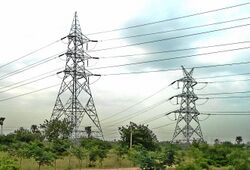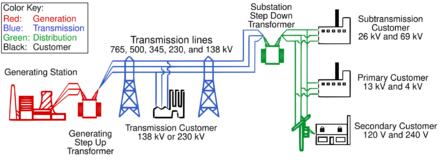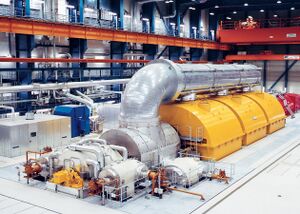Engineering:Centralised generation
Centralised generation refers the common process of electricity generation through large-scale centralised facilities, through Transmission lines to consumer. These facilities are usually located far away from consumers and distribute the electricity through high voltage transmission lines to a substation where it is then distributed to consumers. The basic concept being that incredibly large stations create electricity for a large group of people. The Vast majority of electricity used in Australia as well as the United States is created from Centralised Generation. Most Centralised Power Generation comes from large power plants run by fossil fuels such as coal or natural gas. Nuclear or large hydroelectricity plants are also commonly used.[1] Many disagree with the processes of Centralised Generation as it often relies on electrical generation through processes of the combustion of fossil fuels, which are bad for the environment. However unsustainable the current system is, it is by far the most widely used, reliable and efficient system that is currently in use.
Centralised Generation is fundamentally the opposite of distributed generation. Distributed generation is the small-scale generation of electricity to smaller groups of consumers. This can also include independently producing electricity by either solar or wind power. In recent years Distributed generation as has seen a spark in popularity due to its propensity to use renewable energy generation methods such as wind and solar.
History
In the 1880s the popularity of electricity grew massively with the introduction of the Incandescent light bulb. Although there are 22 recognised inventors of the light bulb prior to Joseph Swan and Thomas Edison, Edison and Swan's invention became by far the most successful and popular of all. During the early years of the 19th century, massive jumps in electrical sciences were made. And by the later 19th century the advancement of electrical technology and engineering led to electricity being part of everyday life. With the introduction of many electrical inventions and their implementation into everyday life, the demand for electricity within homes grew dramatically. With this increase in demand, the potential for Profit was seen by many entrepreneurs who began investing into electrical systems to eventually create the first electricity public utilities. This process in history is often described as electrification.[2]
The earliest distribution of electricity came from companies operating independently of one another. A consumer would purchase electricity from a producer, and the producer would distribute it through their own power grid. As technology improved so did the productivity and efficiency of its generation. Inventions such as the steam turbine had a massive impact on the efficiency of electrical generation but also the economics of generation as well. This conversion ofheat energy into mechanical work was similar to that of Steam engines, however at a significantly larger scale and far more productively. The improvements of these large-scale generation plants were critical to the process of centralised generation as they would become vital to the entire power system that we now use today.
Throughout the middle of the 20th century many utilities began merging their distribution networks due to economic and efficiency benefits. Along with the invention of long-distance power transmission, the coordination of power plants began to form. This system was then secured by regional system operators to ensure stability and reliability. The electrification of homes began in Northern Europe and in the Northern America in the 1920s in large cities and urban areas. It wasn't until the 1930s that rural areas saw the large-scale establishment of electrification.[3]
Technologies
Template:Latest pie chart of world power by sourceCentralised energy sources are large Thermal power stations that produce huge amounts of electricity to a large number of consumers. This is the traditional way of producing energy. Almost all power plants used in centralised generation are thermal power plants meaning that they use a fuel to heat steam to produce a pressurised gas which in turn spins a turbine and generates electricity. This process relies on several forms of technology to produce widespread electricity, these being natural coal, gas and nuclear forms of thermal generation.
Coal
Coal power stations produce steam by burning coal dug up from the earth. This steam, under intensely high-pressure forces into a turbine. These turbines are connected to generators that spin at high speeds creating electricity. Following the generation, the steam is cooled back into water to be heated once again to produce electricity. A single coal power plant can produce electricity for 700,00 homes, however, can use up to 14,000 tonnes of coal a day to heat its boiler. In the United States 37% of all electricity comes from coal[4]
The fundamental issues regarding the use of coal in electricity generation is to with the Greenhouse gasses released by the burning of coal, and the limited amount of coal on earth, leading many to agree that is a very unsustainable way of producing electricity.[5]
Natural gas
Natural gas is ignited to create pressurised gas which is used to spin turbines to generate electricity. Natural gas plants use a gas turbine where natural gas is added along with oxygen which in turn combusts and expands through the turbine to force a generator to spin.
Natural gas power plants are more efficient than coal power generation, they however contribute to climate change but not as highly as coal generation. Not only do they produce carbon dioxide from the ignition of natural gas, but also the extraction of gas when mined releases a significant amount of methane into the atmosphere.[6]
Nuclear
Nuclear power plants create electricity through the process of nuclear fission. Currently nuclear power produces 11% of all electricity in the world. Nuclear reactors use uranium as a source of fuel to power the reactors. When these nuclear atoms are split a sudden release in energy is formed and can be converted into heat. This process is called nuclear fission. Electricity is created through the use of a nuclear reactor where heat produced by nuclear fission is used to produce steam which in turn spins turbines and powers the generators. Although there are several types on nuclear reactors, but all fundamentally use this process.[7]
Although nuclear energy produces very little emissions, several accidents throughout history have led many to speculate the safety and risk associated with these plants. Accidents such as the Chernobyl disaster and the Fukushima Daiichi nuclear disaster have led many to disagree with the practice of nuclear energy generation.[8]
Uses
Although there is variation in the amount of electricity needed at all times, the base load is the minimum amount of energy required at one time, this is the majority of all energy and must be created by large power stations that have the ability to run all day, every day. Only Nuclear, coal, oil, gas and some hydro plants can reliably supply the base load. Many greener methods rely heavily on variables such as the sun and wind and thus their output varies too much to support the base load.
Highly industrial areas tend to be powered almost entirely by thermal energy plants such as coal or gas-powered plants, as their huge power output is necessary to power industry in the region. The localised effect of pollution is also minimal as industrial regions are usually far from suburban areas. The plants can also cope with large variation in power output by adjusting the production of the turbines.
Large thermal power plants produce the vast majority of electricity for residential areas, although there has been an increase in renewable sources of energy, it still only makes up around 8% of all electricity consumed. However, these renewable sources of electricity, aid in fluctuations of electricity demand as they are often easy to adjust the output required to meet the needs of the grid. Through Transmission line the majority of electricity is distributed to residential areas.
Features
The total amount of electricity used fluctuates depends highly on factors such as the time of the day, date and the weather. When demand varies operators must vary total output from the power plants. This is usually done through collaboration with other power plants thus keeping on power grid in an equilibrium. This adds a complication for the entire power grid as it is often difficult to adjust the power output of large thermal power plants. Although confusing and often inefficient, Centralised generation is the most popular way of energy production and distribution in the world. The three major aspects of centralised generation are: generation, transmission and distribution.
Generation
Electricity is generated throughout the world in many ways using a variety of resources. The three most common resources used are natural gas, nuclear and coal. But renewable sources of generation are quickly growing. the most common way to generate electricity is through the transformation of kinetic energy into electricity by large Electric generators. The vast majority of electrical generation is produced through electromagnetic induction, where mechanical energy through a turbine drives a generator rotate to produce electricity.
Often utilities need to purchase more electricity through a wholesale market from a rival utility or wholesale retailer, this is brokered and organised by a regional transmission reliability organisation.[9] It is necessary for utilities to produce electricity far away from consumers as the plants are large and release extensive greenhouse gasses. Thus, there is a major process of transporting electricity from the generation plants to consumers.
Transmission

The electricity that is generated by the utilities is distributed to consumers through transmission lines. High voltage transmission lines such as the ones hung by large metal frames can carry high-voltage electricity to consumers over long distances. High-voltage electricity is far more efficient for travel as less electricity is lost through the lines in its long journey. High voltage (between 69 kV and 138 kV) and ultra-high voltage (345–800 kV) are used for the transmission of bulk electric power either directly to large consumers or to substations. This electricity is eventually sent to substations. These substations can either reduce the voltage so that it can be used by consumers or increase voltage to aid in further travel.[10]
Distribution
Finally, the electricity will travel form substations through distribution lines directly to homes and businesses. Distribution lines are the commonly seen Overhead power lines usually containing low voltage (less than 1000 volts) through two or three lines. However, Medium voltage lines (between 1000 volts and 69kV) are often used for distribution between rural and urban areas. In many urban areas the power lines are placed underground to save space.[11]
Environmental concerns
A fundamental issue regarding centralised generation and the current electrical generation methods in use today is the significant negative environmental effects that many of the generation processes have. Processes such as coal and gas not only release carbon dioxide as they combust, but their extraction from the ground also impacts the environment. Open pit coal mines use large areas of land to extract coal and limit the potential for productive land use after the excavation. Natural gas extraction releases large amounts of methane into the atmosphere when extracted from the ground greatly increase global greenhouse gasses. Although nuclear power plants to not release carbon dioxide through electricity generation, there are significant risks associated with nuclear waste and safety concerns associated with the use of nuclear sources. This fear of nuclear power stems from large-scale nuclear catastrophes such as the Chernobyl Disaster and the Fukushima Daiichi nuclear disaster. Both tragedies led to significant casualties and the radioactive contamination of large areas.[12]
Centralised generation vs distributed generation
Centralised generation vs distributed generation is an argument that has recently surfaced, with many claiming that centralised generation is a way of the past and that distributed generation is the future of electricity production. Distributed Generation is the process of small-scale production of electricity often by individuals having their own way of producing energy that they then use.[13] Distributed energy is usually described as using environmentally sustainable practices such as solar or wind opposed to nuclear, gas or coal. An example of this would be solar panels on one's house or a small local energy producer. Distributed energy is usually seen as far better for the environment as it does not use large thermal combustion to produce energy. It also does not rely on a network of power grids that can often be unreliable and leave many without power. Over the past few years many there has been a major increase in the use of Distributed Generation as many governments are promoting the use of this technology through subsidies as a way of reducing greenhouse emissions.[14][15]
See also
- Cogeneration: the use of a heat engine or power station to generate electricity and useful heat at the same time.
- Cost of electricity by source
- Diesel generator
- Electric generator
- Engine-generator
- Electric power transmission
- World energy consumption: the total energy used by all of human civilization.
- Electrification
- Nuclear fission
References
- ↑ US EPA, OAR (4 August 2015). "Centralized Generation of Electricity and its Impacts on the Environment" (in en). https://www.epa.gov/energy/centralized-generation-electricity-and-its-impacts-environment.
- ↑ "History of Electrification Sites". https://edisontechcenter.org/HistElectPowTrans.html.
- ↑ "Power Grid History". https://www.itc-holdings.com/a-modern-power-grid/power-grid-history.
- ↑ "Generating Electricity from Coal" (in en). https://www.duke-energy.com/energy-education/how-energy-works/electricity-from-coal.
- ↑ "How Energy Works, Electricity from coal". https://www.tva.com/Energy/Our-Power-System/Coal/How-a-Coal-Plant-Works.
- ↑ "Natural gas power plant – Energy Education" (in en). https://energyeducation.ca/encyclopedia/Natural_gas_power_plant.
- ↑ "Nuclear power – Energy Education" (in en). https://energyeducation.ca/encyclopedia/Nuclear_power.
- ↑ "Nuclear Power and the Environment – Energy Explained, Your Guide To Understanding Energy – Energy Information Administration". https://www.eia.gov/energyexplained/index.php?page=nuclear_environment.
- ↑ "How Electricity Is Delivered To Consumers – Energy Explained, Your Guide To Understanding Energy – Energy Information Administration". https://www.eia.gov/energyexplained/index.php?page=electricity_delivery.
- ↑ "Electricity Explained, How Electricity Is Delivered To Consumers". 2018. https://www.eia.gov/energyexplained/index.php?page=electricity_delivery.
- ↑ "How Electricity Is Delivered To Consumers – Energy Explained, Your Guide To Understanding Energy – Energy Information Administration". https://www.eia.gov/energyexplained/index.php?page=electricity_delivery.
- ↑ "The Worst Nuclear Disasters of All Time" (in en). https://www.worldatlas.com/articles/deadliest-nuclear-and-radiation-disasters-in-history.html.
- ↑ Momoh, J (2012). "Centralised and Distributed Generated Power Systems – A Comparison Approach.". Howard University: 1–23.
- ↑ Farrell |, John (17 October 2011). "The Challenge of Reconciling a Centralized v. Decentralized Electricity System" (in en). https://ilsr.org/challenge-reconciling-centralized-v-decentralized-electricity-system/.
- ↑ Green, D (2015). "Centralised to decentralised energy: What does it mean?". https://reneweconomy.com.au/centralised-decentralised-energy-mean-34072/.




